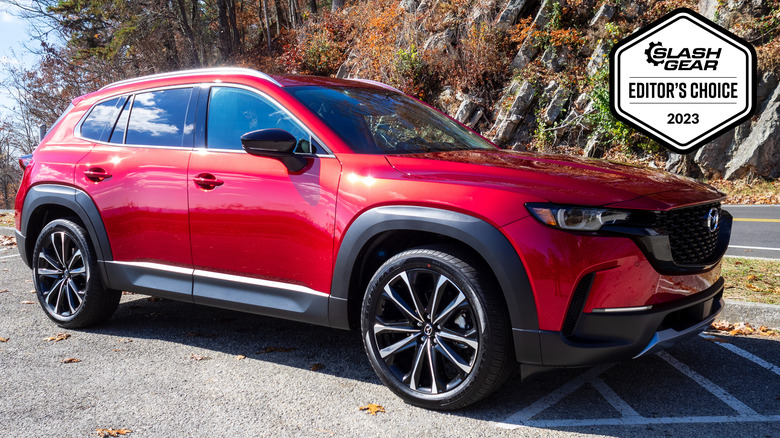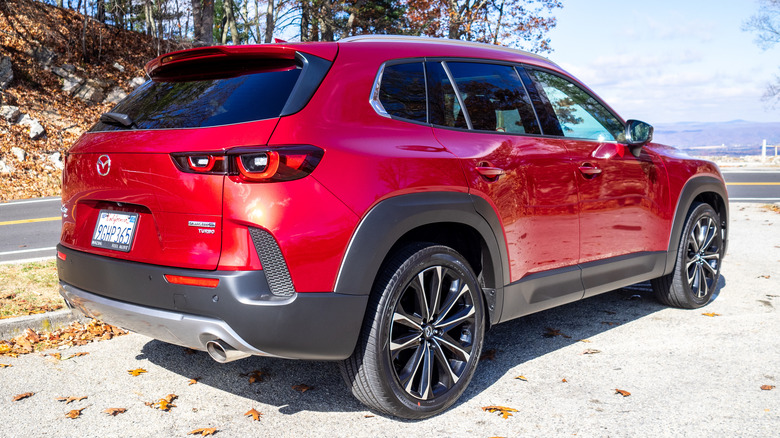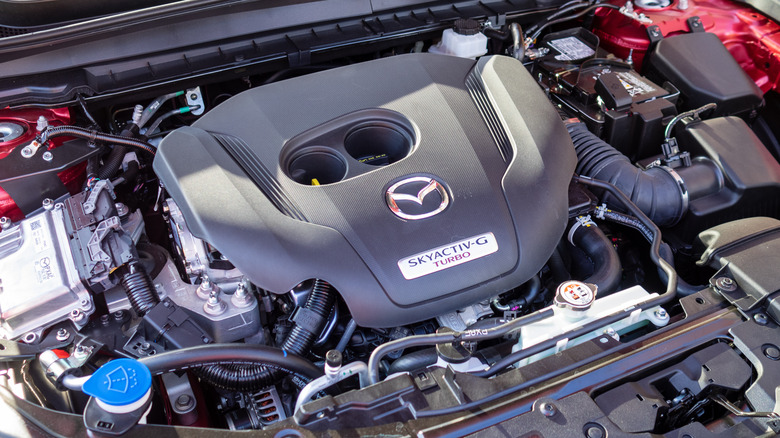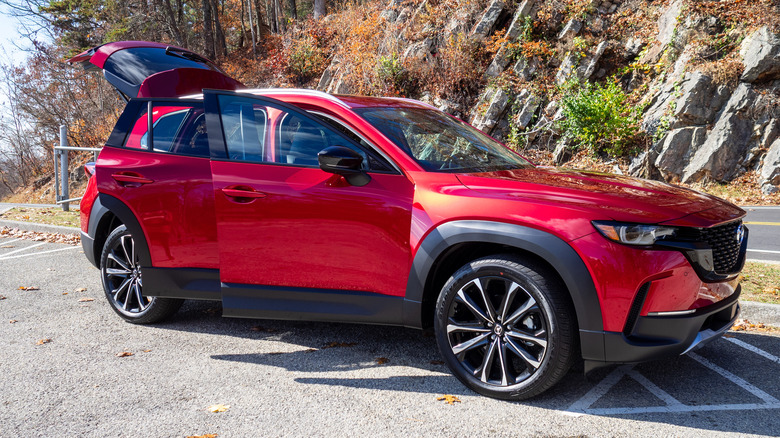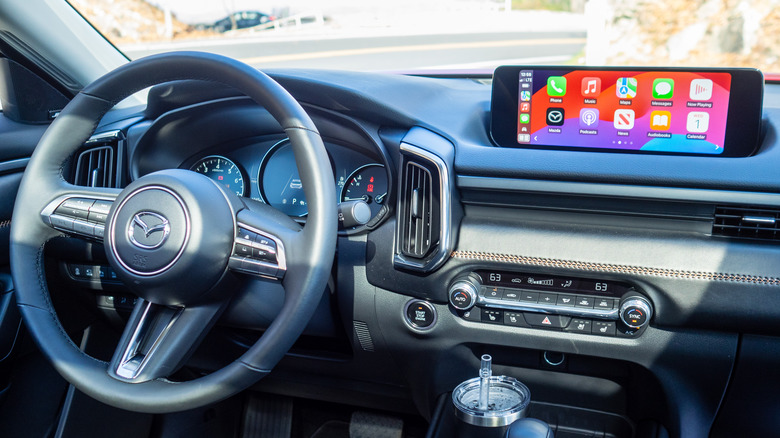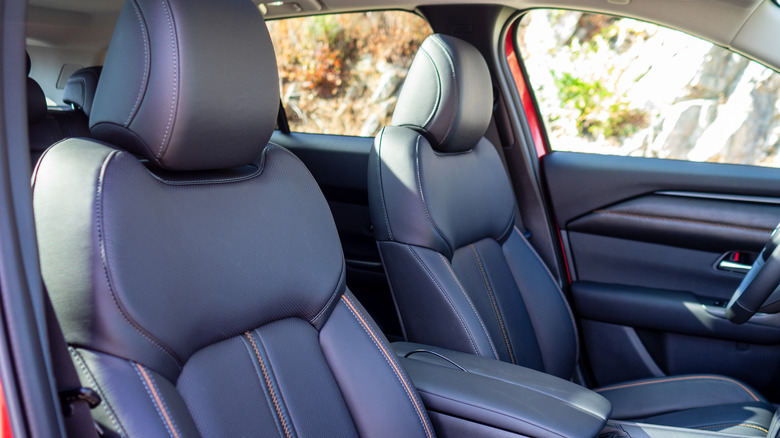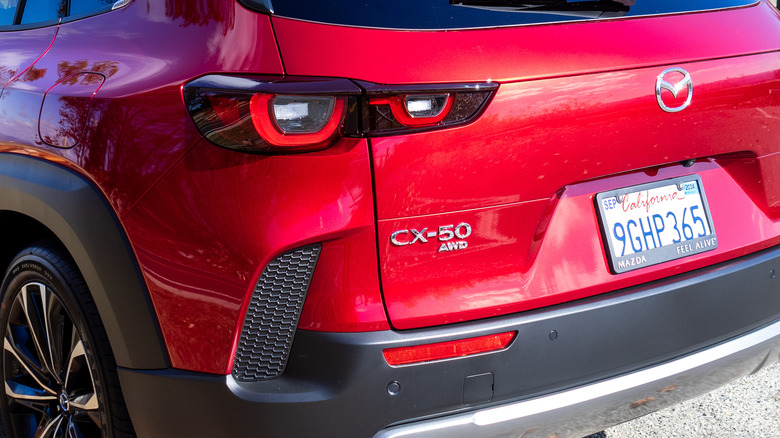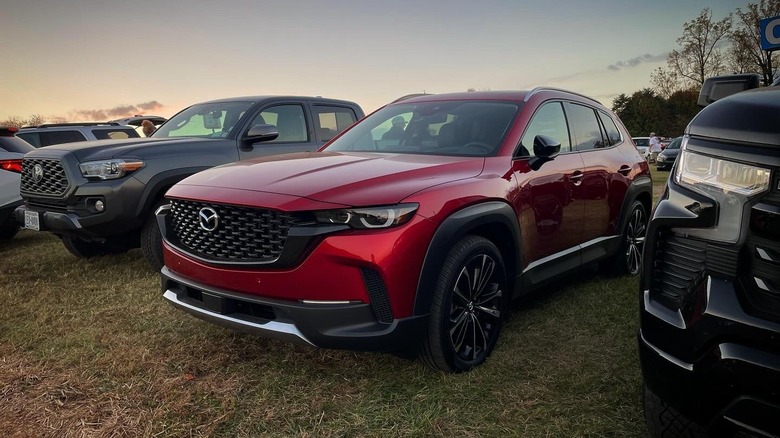2024 Mazda CX-50 Review: The CX-5 Scaled For The Great Outdoors
- Signature Soul Red Crystal Metallic paint remains a stunner years later
- Handling is excellent
- Lives up to the "zoom-zoom-zoom" promise
- Out-tows most of the competition
- Dial-controlled infotainment system not for everyone
- Getting the most out of the turbocharged powertrain means ponying up for premium
- No hybrid version
Mazda's path over the past few decades has been to build and sell vehicles that are all about, as the marketing once said, the "zoom-zoom-zoom." From the legendary MX-5 and iconic RX-7 all the way to its current crossover lineup, each Mazda model promises premium features with the sort of performance that can only be derived from the Japanese automaker's time on the track. Thus, every trip to the mall, every commute to work, every big outing in the great wide open can feel like piloting an MX-5 Cup car around Watkins Glen or the legendary 787B around Le Mans, even if it's in a front-drive CX-30.
What Mazda hasn't done is bring its "joy of driving" to the great outdoors. Sure, there are windy roads that go through the forests and mountains that Mazdas have worked their magic upon, but none have ventured off onto the trails where the Ford Bronco Sport, Jeep Compass, Honda CR-V and Toyota RAV4 all spend their time when not battling rush-hour traffic or running errands in-town. Until now.
Back in 2022, Mazda delivered the first examples of its first off-road centric crossover, the CX-50, to showrooms across North America. Sure, this new Mazda won't be scaling anything on the Rubicon Trail or in Moab, Utah, but does it deliver the "zoom-zoom-zoom" to the trails other soft-roaders occupy? To find out, Mazda sent down a 2024 CX-50 in its top-tier 2.5 Turbo Premium Plus trim to my home in Virginia's New River Valley.
There's a Mazda3 here
The CX-50 is not only Mazda's first off-road centric crossover, it's the automaker's first vehicle of any type to be built in the United States in over a decade after the last U.S.-built Mazda 6 rolled off the line out of Flat Rock, Michigan. This new compact crossover is produced for the North American market at the Mazda Toyota Manufacturing USA plant in Huntsville, Alabama, sharing assembly space (and nothing else) with the Toyota Corolla Cross. However, the CX-50 rides on the same platform underpinning the Mazda 3, CX-30, and MX-30. It also shares the first four characters of its name with the CX-5, but doesn't have much more in common beyond that.
For one, the CX-5 is smaller than the CX-50, but just a bit bigger than the CX-30. For another, the CX-50's roofline is lower than that of the CX-5's — despite riding higher than the latter — to enable easier access to whatever roof racks and carriers are placed above the panoramic glass roof for placement of tents, bikes, canoes, and/or other gear for the big adventure under the stars.
A third difference is that the CX-5, though it can be had with all-wheel drive, is dressed for highways and city streets. The CX-50, in contrast, throws in plastic cladding over the wheel wells and lower trim pieces to keep branches and brambles at bay from the paint; the 2.5 Turbo Meridian Edition adds 18-inch wheels and all-terrain tires for more ruggedness.
There's definitely some zoom-zoom-zoom here
There are two engine choices putting the power down to the ground. The non-turbo trims use the SKYACTIV-G 2.5-liter inline-four with cylinder deactivation, funneling 187 horsepower and 186 lb.-ft. of torque through the six-speed automatic to all corners. Meanwhile, the turbocharged trims receive the SKYACTIV-G Turbo 2.5-liter.
Output varies on what's in the fuel tank. If you're trying to save money at the pump by filling the CX-50 with regular 87 octane, you'll have a respectable 227 horses and 310 lb.-ft. of torque to carry you and yours through the trails. Step up to premium 93 octane, though, and you'll unlock every bit of 256 horsepower and 320 lb.-ft. of torque for the liveliest of treks into the mountains. The turbocharged models also give the CX-50 the ability to tow up to 3,500 pounds, outpulling the Honda CR-V Hybrid (1,000 pounds), the Mazda CX-30 and CX-5 (2,000 pounds), and the Ford Bronco Sport (2,200 pounds), and matching up with the Toyota RAV4 and Ford Escape.
As for the wheels and rubber, the 2.5 S Select, Preferred, and Premium trims use 17-inch aluminum alloys, while the aforementioned Meridian Edition combines 18-inch aluminum alloy wheels with all-terrain tires. The rest of the lineup from Premium Plus into the turbocharged trims rock a full set of 20-inch aluminum alloys wrapped in Goodyear Eagle Touring all-seasons. Four-wheel independent suspension with MacPherson struts and a stabilizer bar up front with torsion beams in the rear are ready to handle any bumps and jolts to the campsite. A pair of 12.8-inch vented discs up front and 12.8-inch solid discs in the back bring everything to a halt.
An environmentally friendly (red) soul
The 2024 Mazda CX-50 not only is built with the great outdoors in mind: so, too, is the paint it wears, including the company's signature Soul Red Crystal Metallic. It's applied using Mazda's Aqua-Tech Paint System, an environmentally friendly painting technique promising artisan-results on a mass scale. It proved good enough to earn the Japanese government's Prime Minister Award in 2015 in the Manufacturing and Production Process Category, not least because the water-based system reduces volatile organic compound emissions by 78% over other automotive painting methods. Mazda also reduced CO2 emissions from its paint booths by 34%, without using any extra energy in the process.
The Aqua-Tech system uses a three-layer wet paint process, which includes high-brightness aluminum flakes and light-absorbing flakes all dropped into the paint. The final result is best seen in person, as the camera lens can't see what you and I see in the showroom or under the bright blue skies.
Dialing-up the infotainment
The 2024 Mazda CX-50 comes loaded with plenty of tech, including wireless charging plus wireless Apple CarPlay and Android Auto. Your phone's infotainment is displayed upon the 10.25-inch center display, which is controlled by a dial between the shifter and the wireless charging pad on the center console. Those who prefer touching the screen may find twisting and shifting the dial around not their cup of tea, but at least the center display won't need cleaning every so often, right?
Thankfully, the radio and HVAC controls are also physical knobs and buttons, though the radio volume knob is next to the big touchscreen control dial instead of with the aforementioned HVAC controls. Lower non-turbo and turbocharged trim levels deliver your favorite radio stations — including the prerequisite SiriusXM and HD Radio stations — through an eight-speaker setup, while the premium trims get a 12-speaker Bose sound system to make those sports scores and indie folk songs sound their absolute best. There's also in-car wi-fi, though that's a subscription service with a three-month trial. Mazda's own suite of connected services, including remote services, vehicle health and navigation, are available for free for the first three years of ownership.
As for keeping you and yours safe on the road and trail, standard features include lane keeping and lane departure warning, blind-spot monitoring, rear cross-traffic alert, smart braking assist, adaptive cruise control, and driver attention monitoring. Optional extras include a head-up display, traffic jam monitoring, blind-spot assist, and rear smart braking support.
Bringing the luxury to the great outdoors
When not setting up the pop-up tent on the roof for that week-long overlanding adventure, up to five occupants can enjoy either half leatherette- or leather-trimmed seating, depending on trim level. The front seats come with standard heating, though stepping up to the more premium trims add ventilation, as well as adding heating to the rear 60/40 bench and the steering wheel. Rear privacy glass is standard, while the panoramic sunroof — a first for any Mazda crossover — welcomes in the blue skies and golden rays of light.
Open the rear power liftgate, and you'll find plenty of room to store all of your camping gear or shopping bags. With the 60/40-split rear bench up, cargo room comes to 31.4 cubic feet, which is more than enough for most of life's daily needs. Drop the rear bench down entirely, and you'll have 56.3 cubic feet of space to fill with sleeping bags, big 'n' sturdy coolers, camping stoves, bike parts and anything else you might need for the big overlanding trip into the woods.
And if you need even more room for your gear — including that aforementioned pop-up tent — the roof line is lower than that of the CX-5, meaning easier access to the top. Mazda can even outfit your CX-50 for adventure with its line of accessories, including crossbars, roof platforms, various attachments for bikes and kayaks, trailer hitch cargo boxes, and yes, even a rooftop pop-up tent.
Cruising down to the Southside
Though no camping trips were on the schedule during my time with the 2024 Mazda CX-50, a special trip down to Martinsville Speedway in Ridgeway, Virginia was in the cards. A few months earlier, IMSA's MX-5 Cup visited the half-mile paved oval to determine if it would be feasible to bring the fastest MX-5s around to "The Paperclip." This time around, though, this Mazda would be taking me to my second-ever NASCAR Cup event, the 2023 Xfinity 500. The most direct way to Virginia's Southside from my home would be down a couple of state roads towards U.S. 220 and the speedway, a 90-minute trek through winding roads and falling leaves.
The compact crossover "zoom-zoom-zoomed" its way through the falling leaves between the New River Valley and the Southside, gliding through the slow-speed twists and turns with the race-inspired handling all Mazdas are known for. It also hustled past more than a few big rigs on my usual loop along I-81 to Draper Mountain Valley Overlook in Pulaski County, Virginia by switching the Mazda Intelligent Drive Select into Sport mode.
Fuel economy is 24 mpg city/30 mpg highway for non-turbo models, 23 city/29 highway for the turbocharged ones. I managed an average of 22.5 mpg due to mostly in-town driving. The CX-50 may not be leading the MX-5 Cup pack around Martinsville next year, but it would be fun to take around the half-mile track for a spirited few laps on the days the track is open to the public for such activities.
2024 Mazda CX-50 Verdict
Starting price for the 2024 CX-50 is $30,300 for the base 2.5 S Select, running through to $45,270 — including a $1,375 for delivery — as-tested for the top-tier 2.5 Turbo Premium Plus trim level. In contrast, the 2024 Honda CR-V starts for a bit less at $29,500, but you'll need the hybrid — from $35,200 for the Hybrid Sport AWD — to somewhat match the Mazda's on-road capability, while towing 2,500 pounds less.
The 2024 Ford Bronco Sport can out off-road the CX-50 for a starting price of $31,320, with similar MPG from its turbo-three or turbo-four powertrains, and comes with a lot more outdoor gear from Ford and its partner vendors in the aftermarket. Finally, the 2024 Toyota RAV4 offers more cargo space (37.6 to 69.8 cubic feet) and equal towing power for a starting MSRP of $29,875.
The 2024 CX-50 adds a fun twist to what we've seen of compact SUVs from Mazda. That it's the automaker's first off-road centric crossover, with the company going all-in on accessories to outfit it for the great outdoors, may draw more than a few Mazda fans looking to bring their favorite brand out on the trail. Again, it's not going to hang with the big Jeeps and Land Rovers on the toughest terrains and trails, but it might just give the more rugged soft-roaders in its class pause at the local campground. If it's driving fun you're after, and you don't mind spending a bit more, the 2024 Mazda CX-50 should be on your shortlist.
